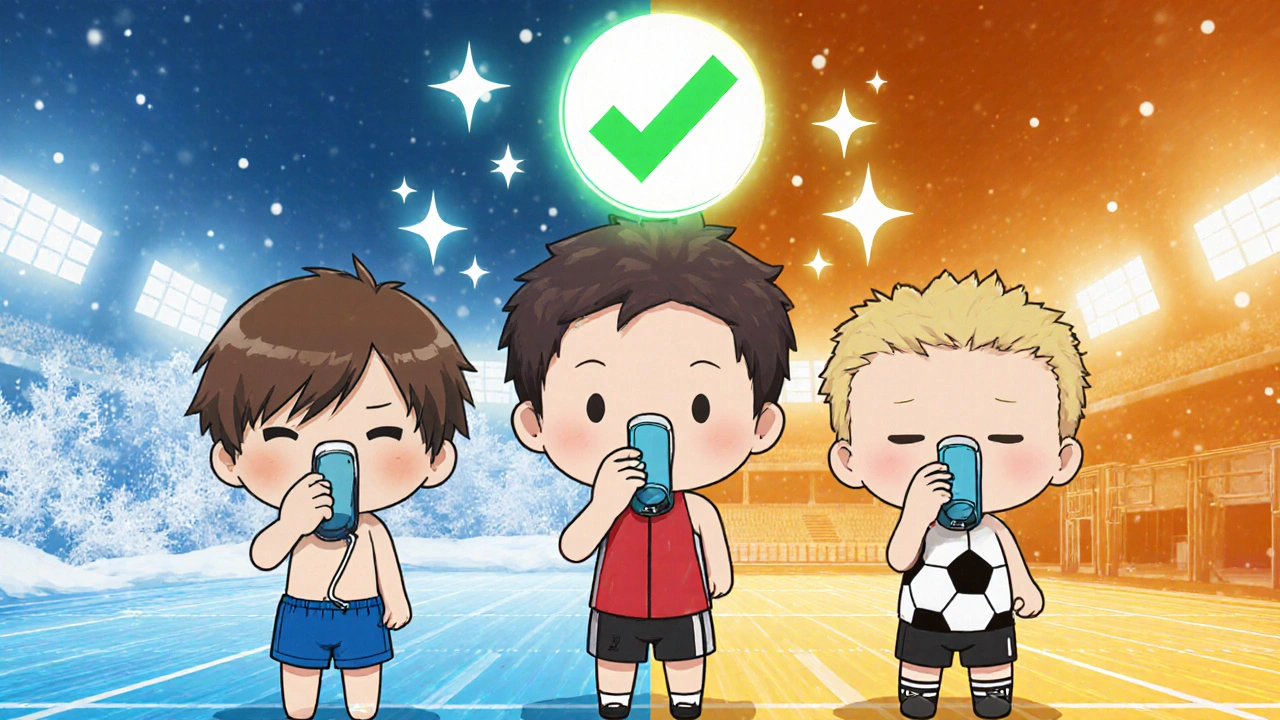What Is Exercise-Induced Bronchoconstriction?
Exercise-induced bronchoconstriction (EIB) isn’t asthma, but it feels like it. You’re running, swimming, or playing soccer, and suddenly your chest tightens, you can’t catch your breath, and a dry cough kicks in. It hits fast-usually within 5 to 20 minutes after you start exercising-and fades within an hour. About 1 in 5 people without asthma get it. Among those with asthma, it’s nearly universal. It’s not weakness. It’s physiology. When you breathe fast and hard during exercise, your airways lose heat and moisture. That triggers inflammation and tightening of the muscles around your bronchial tubes. The result? Shortness of breath, wheezing, chest tightness. It’s real, measurable, and completely manageable.
Why Most People Get It Wrong
Too many people think they’re just out of shape. Or they blame the cold air. Or they stop exercising altogether. That’s the biggest mistake. Avoiding activity because of EIB leads to weight gain, lower fitness, and even social isolation. Studies show 68% of undiagnosed people reduce their physical activity, which only makes things worse. The truth? EIB isn’t a reason to sit out-it’s a reason to get smarter about how you move. You don’t need to quit sports. You need the right tools.
The Two-Step Prevention Strategy
There are two proven ways to stop EIB before it starts: non-drug tricks and medication. Start with the non-drug stuff. First, warm up. Not a quick stretch. A 10- to 15-minute moderate workout-like brisk walking or light cycling-followed by a 5-minute rest before your main activity. This triggers something called the "refractory period," where your airways stay relaxed for up to two hours. It’s like giving your lungs a shield. Second, avoid triggers. Cold, dry air is the worst offender. If it’s below 10°C (50°F) or humidity is under 40%, move indoors. Pollen counts over 9.7 grains/m³ or air quality index above 50? Also skip outdoor exercise. You don’t need fancy masks. A simple scarf over your mouth in winter helps more than most commercial products.
Choosing the Right Sport
Not all exercise is equal when it comes to EIB. Endurance sports like cross-country skiing, ice hockey, and long-distance running trigger symptoms in up to 85% of people with EIB. Why? Constant heavy breathing. On the other hand, sports with short bursts-like football, baseball, wrestling, or sprinting-only cause problems in about 22% of cases. That’s because you’re not breathing nonstop. If you’re just starting out, pick activities that let you catch your breath. You can still train for endurance later, once you’ve got your prevention routine down.

Inhaler Use: Timing and Technique Matter
Short-acting beta-2 agonists (SABAs) like albuterol are the gold standard. They work fast and well-80% to 90% effective when used right. But timing is everything. Take two puffs (90 mcg each) 5 to 20 minutes before exercise. Don’t wait until you’re already struggling. And don’t skip the spacer. Using a spacer increases lung delivery by 70%. Without it, most of the medicine hits your throat and gets swallowed. Hold your breath for 10 seconds after inhaling. That’s not optional-it boosts lung deposition by 30%. Store your inhaler at room temperature (20-25°C). Cold temperatures make the propellant less effective by 40%. Replace your spacer every 6 months. Plastic cracks over time, and that cuts efficiency by 25%.
What If the Inhaler Doesn’t Work?
One in three people still have symptoms even after using albuterol. That’s not failure-it’s a sign you need more. If you’re using your rescue inhaler more than twice a week for EIB, you likely have underlying airway inflammation. That’s where daily inhaled corticosteroids (ICS) come in. Fluticasone at 200-400 mcg daily reduces symptoms by 50-60%. Another option is montelukast, a daily pill that blocks inflammatory chemicals. It’s not as strong as ICS, but it helps 30-40% of people and avoids steroid side effects. Combination therapy-SABA plus ICS-cuts symptom frequency by 78% compared to SABA alone. For elite athletes, this is routine. For everyone else, it’s often overlooked.
What About Diet and Supplements?
You’ll see claims about omega-3s, vitamin C, and magnesium helping EIB. There’s some science behind it. One study found 500mg of vitamin C daily reduced symptoms by 48% in people with low baseline levels. Omega-3 supplements (2-4 grams daily for 3 weeks) cut rescue inhaler use by 31%. But here’s the catch: these aren’t magic pills. They’re supportive tools, not replacements. The Mayo Clinic says there’s not enough evidence to recommend them for everyone. If you already eat fatty fish, take a multivitamin, or have low vitamin C levels, they might help. But don’t expect them to replace your inhaler.
When to See a Doctor
If you’ve never been tested for EIB, get checked. A simple exercise challenge-running on a treadmill or cycling at 80-90% max heart rate for 6-8 minutes-can confirm it. Your doctor will measure your lung function before and after. If your FEV1 drops by 10% or more, you have EIB. Don’t assume you have asthma just because you wheeze during exercise. Many people don’t. But if you’re using your inhaler regularly, you need to rule out chronic inflammation. Overreliance on albuterol without addressing inflammation can mask worsening airway damage. The American Thoracic Society warns that 15-20% of patients who only use rescue inhalers develop more persistent symptoms over time.
What’s New in EIB Management
Technology is catching up. Smart inhalers with Bluetooth sensors now track when and how often you use them. One study showed 47% better adherence with these devices. They don’t cure EIB, but they help you stick to your plan. Emerging research is also looking at biomarkers like fractional exhaled nitric oxide (FeNO). If your FeNO level is above 25 ppb, you’re more likely to respond well to inhaled steroids. This could mean personalized treatment in the future. For now, the basics still win: warm up, avoid triggers, use your inhaler right, and don’t give up on movement.
The Bottom Line
EIB doesn’t have to hold you back. With the right approach, 95% of people can participate fully in any sport or activity they love. The key isn’t more medication-it’s better timing, better technique, and better habits. Skip the guesswork. Warm up. Use a spacer. Take your inhaler before you start. Avoid cold, dry air. If you’re still struggling, talk to your doctor about daily controller meds. And never, ever stop moving. The cost of inactivity is far greater than the effort it takes to manage EIB.
Can you outgrow exercise-induced bronchoconstriction?
Some people do, especially children and teens, as their airways mature and their fitness improves. But for many, EIB is a lifelong condition that needs management-not a phase to wait out. Even if symptoms lessen, the underlying sensitivity often remains. That’s why consistent prevention strategies are important at every age.
Can you use an inhaler during exercise if symptoms start?
Yes, but it’s not ideal. Rescue inhalers work best when used before symptoms start. Taking one mid-exercise can help, but it’s slower and less effective than pre-treatment. You might still feel tightness while you’re waiting for the medicine to kick in. Prevention is always better than reaction.
Is EIB the same as asthma?
No. EIB is a temporary narrowing of the airways triggered only by exercise. Asthma is a chronic condition with inflammation that can flare up from many triggers-like allergens, cold air, or stress. Many people with asthma have EIB, but you can have EIB without ever having asthma. The treatment is similar, but the long-term management differs.
Do I need a prescription for an EIB inhaler?
Yes. Short-acting beta-2 agonists like albuterol are prescription medications in the UK and most countries. Even if you think you know what you need, you should be diagnosed first. Self-treating without confirmation can mask other conditions or lead to overuse. Always get tested and follow your doctor’s advice.
Can I use my inhaler before swimming?
Yes, and you should. Chlorine in pools can irritate airways, and the humidity doesn’t always protect you. Many swimmers with EIB still experience symptoms. Use your inhaler 15-20 minutes before getting in the water, even if the pool is warm. A warm-up and spacer are just as important here as with running or cycling.
How do I know if my inhaler is working?
You should feel relief within 5 minutes, and your symptoms should stay away for 2-4 hours. If you still get tightness or coughing after using it correctly, your dose may be too low, or you may need a daily controller medication. Track your symptoms for a week and talk to your doctor. Don’t assume it’s just "not working"-you might be using it wrong.
Is it safe to use an inhaler every day for EIB?
Short-acting inhalers like albuterol are safe for daily use if needed before exercise. But if you’re using them more than twice a week for EIB, you likely need a daily controller like an inhaled steroid. Daily SABA use without a controller can hide worsening inflammation. Your doctor can help you find the right balance.
Can children use EIB inhalers safely?
Yes. Albuterol is approved for children as young as 4 years old, and spacers with masks are recommended for younger kids. EIB is common in children, especially those with allergies or eczema. Early diagnosis and treatment help them stay active, avoid weight gain, and develop healthy habits. Always use a spacer and check technique regularly-kids often inhale too fast or don’t hold their breath.
